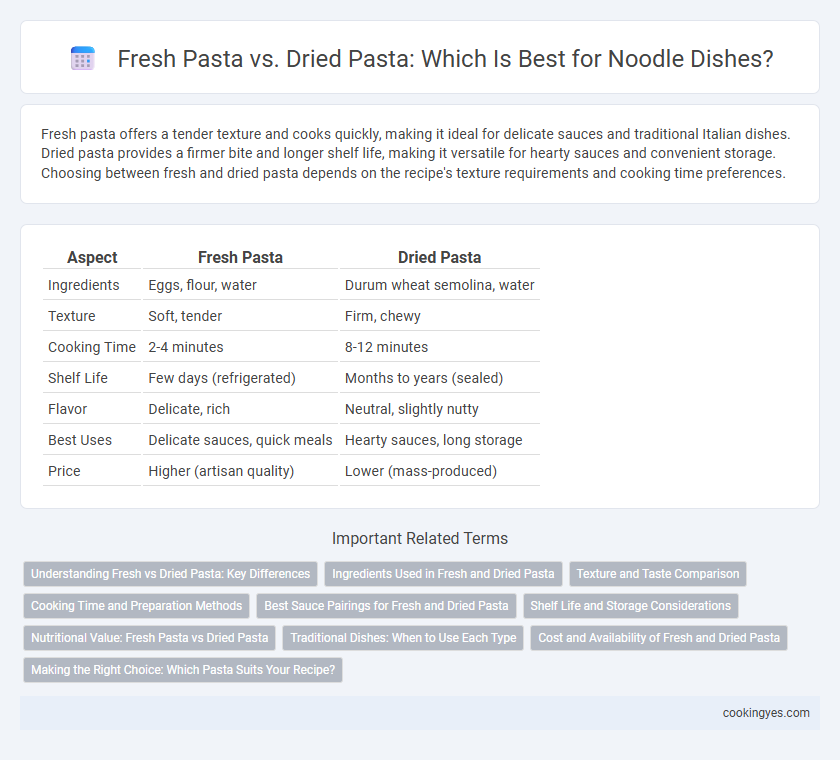Fresh pasta offers a tender texture and cooks quickly, making it ideal for delicate sauces and traditional Italian dishes. Dried pasta provides a firmer bite and longer shelf life, making it versatile for hearty sauces and convenient storage. Choosing between fresh and dried pasta depends on the recipe's texture requirements and cooking time preferences.
Table of Comparison
| Aspect | Fresh Pasta | Dried Pasta |
|---|---|---|
| Ingredients | Eggs, flour, water | Durum wheat semolina, water |
| Texture | Soft, tender | Firm, chewy |
| Cooking Time | 2-4 minutes | 8-12 minutes |
| Shelf Life | Few days (refrigerated) | Months to years (sealed) |
| Flavor | Delicate, rich | Neutral, slightly nutty |
| Best Uses | Delicate sauces, quick meals | Hearty sauces, long storage |
| Price | Higher (artisan quality) | Lower (mass-produced) |
Understanding Fresh vs Dried Pasta: Key Differences
Fresh pasta contains higher moisture content, making it softer and quicker to cook, ideal for delicate sauces and dishes requiring a tender texture. Dried pasta has a lower moisture level, offering a firmer bite and longer shelf life, perfect for hearty sauces and recipes needing more al dente firmness. Understanding these differences helps in selecting the right pasta type to complement specific noodle dishes and cooking methods.
Ingredients Used in Fresh and Dried Pasta
Fresh pasta ingredients typically include eggs, flour, and water, creating a tender texture ideal for delicate sauces. Dried pasta is made primarily from durum wheat semolina and water, giving it a firmer consistency and longer shelf life. The higher protein content in durum wheat used for dried pasta enhances its elasticity and cooking durability compared to fresh pasta.
Texture and Taste Comparison
Fresh pasta features a tender, delicate texture with a subtle, rich egg flavor that absorbs sauces quickly, making it ideal for light, creamy dishes. Dried pasta offers a firmer, chewier bite and a more neutral taste, perfect for hearty, robust sauces that cling well to its dense structure. The choice between fresh and dried pasta significantly influences the overall mouthfeel and flavor profile of noodle-based recipes.
Cooking Time and Preparation Methods
Fresh pasta cooks significantly faster, typically requiring only 2 to 4 minutes due to its higher moisture content and delicate texture, making it ideal for quick meals. Dried pasta demands longer cooking times, averaging 8 to 12 minutes, as it is dehydrated and tougher, providing more shelf stability and a chewier texture. Preparation methods for fresh pasta involve immediate cooking or quick boiling, while dried pasta requires boiling in ample water, often with added salt, to achieve the perfect al dente consistency.
Best Sauce Pairings for Fresh and Dried Pasta
Fresh pasta, made from eggs and flour, pairs best with delicate sauces such as butter and sage, light cream sauces, or simple tomato-based recipes that highlight its tender texture. Dried pasta, typically made from durum wheat semolina, holds up well to robust, hearty sauces like Bolognese, ragu, and chunky vegetable sauces due to its firmer bite and longer cooking process. Choosing the right sauce enhances the unique texture and flavor profile of both fresh and dried pasta varieties, ensuring a balanced and satisfying dish.
Shelf Life and Storage Considerations
Fresh pasta has a significantly shorter shelf life, typically lasting 2 to 3 days in the refrigerator, requiring airtight containers to maintain moisture and prevent spoilage. Dried pasta can be stored for up to 1 to 2 years in a cool, dry place, making it ideal for long-term storage without refrigeration. Proper storage of fresh pasta is crucial to avoid mold growth, while dried pasta benefits from protection against humidity to preserve its quality.
Nutritional Value: Fresh Pasta vs Dried Pasta
Fresh pasta contains higher moisture content, resulting in a softer texture and quicker cooking time, while providing slightly more protein and fewer preservatives compared to dried pasta. Dried pasta is richer in fiber due to longer drying processes and often has a higher carbohydrate concentration, making it a more energy-dense option suitable for longer storage. Both types offer essential nutrients from durum wheat, but fresh pasta retains more nutrients prone to degradation during drying.
Traditional Dishes: When to Use Each Type
Fresh pasta's delicate texture and shorter cooking time make it ideal for traditional Italian dishes such as Tagliatelle al Ragu and Tortellini in Brodo, where a tender bite enhances the sauce absorption. Dried pasta's firm structure and longer shelf life suit hearty recipes like Spaghetti Bolognese and Lasagna, providing a consistent al dente texture that holds up well under slower cooking methods. Selecting fresh or dried pasta depends on the dish's cooking style and flavor profile, maximizing authenticity and taste.
Cost and Availability of Fresh and Dried Pasta
Fresh pasta generally costs more than dried pasta due to its shorter shelf life and the need for refrigeration, making it less readily available in many grocery stores. Dried pasta is more cost-effective and widely accessible, with a longer shelf life that allows it to be stocked in virtually all supermarkets year-round. The convenience and affordability of dried pasta often make it the preferred choice for everyday meals.
Making the Right Choice: Which Pasta Suits Your Recipe?
Fresh pasta offers a tender texture and cooks quickly, making it ideal for delicate sauces like Alfredo or seafood-based recipes, while dried pasta provides a firmer bite and longer shelf life, perfect for hearty dishes such as Bolognese or baked pasta casseroles. Choosing between fresh and dried pasta depends on the sauce consistency and cooking time; fresh pasta absorbs lighter sauces better, whereas dried pasta holds up well under robust, chunky sauces. Understanding these distinctions ensures the right pasta variety enhances the overall flavor and texture of your noodle dish.
Fresh pasta vs Dried pasta for noodles Infographic

 cookingyes.com
cookingyes.com